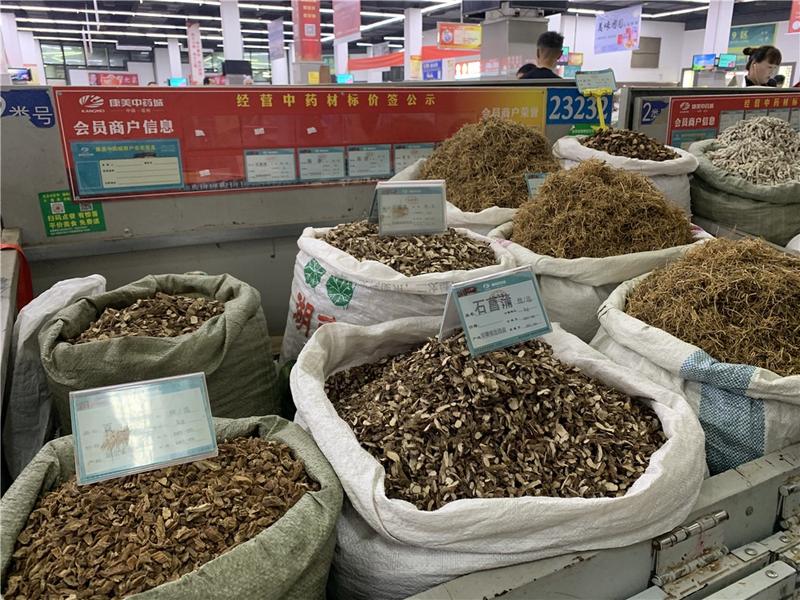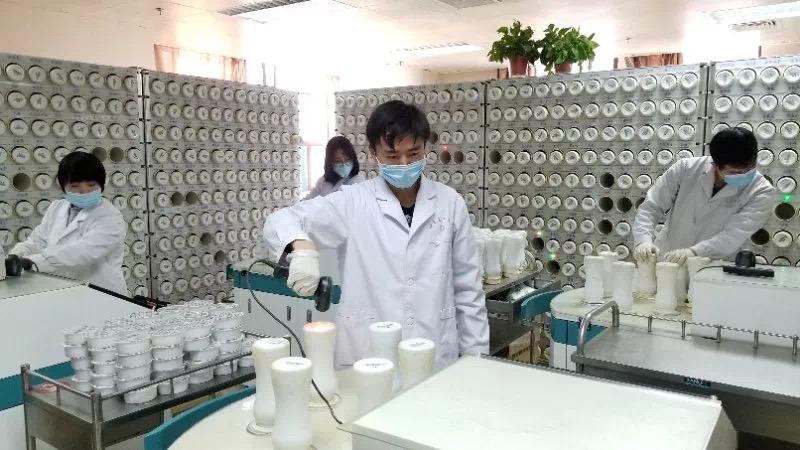 This undated photo shows traditional Chinese medicine supplies for sale at the Chinese Medicinal Herbs Market in Bozhou. (FAN YUANYUAN / CHINADAILY.COM.CN)
This undated photo shows traditional Chinese medicine supplies for sale at the Chinese Medicinal Herbs Market in Bozhou. (FAN YUANYUAN / CHINADAILY.COM.CN)
After practicing traditional Chinese medicine for seven years in Hangzhou, Zhejiang province, Li Xiao arrived in Romania in early February to treat patients on foreign soil for the first time.
"I did not expect TCM to be so welcomed by locals," said Li, from the Third Affiliated Hospital of Zhejiang Chinese Medical University. "Every day we had full appointments despite limitations on the number of patients due to the COVID-19 pandemic."
Although he has a certificate to practice TCM in China, Li had to get one authorized by the Romanian government before he could practice at a TCM center at Vasile Goldis Western University of Arad, in Arad county, western Romania. The center was established by the university and Zhejiang Chinese Medical University in December.
By the end of last year, TCM had spread to 183 countries and regions, and TCM cooperation between governments and education sectors in China and other countries had intensified, according to the National Administration of Traditional Chinese Medicine
Li, a practitioner of acupuncture and tuina, a traditional, massage-like body therapy, found most of his patients had conditions such as cervical vertebrae syndrome and slipped disks that he said modern medicine had failed to resolve. To his surprise, he found the TCM techniques seemed to work on foreigners better than on Chinese.
"Back in Hangzhou, patients with such conditions may see improvement after five or six sessions of tuina, but the patients from Arad said they could feel their ailments relieved after just one or two," Li said. "Most of my patients in Arad had never received TCM therapies, so they may have been more sensitive to them."
Despite great demand, there was a severe shortage of professional TCM practitioners in Romania, and it was rare to see a Chinese TCM practitioner with professional training in Arad, said Li, who returned to Hangzhou in July.
As more TCM doctors go abroad to practice and international exchanges become more frequent, the ancient Chinese medical system, which has been practiced in China for thousands of years, is bringing health benefits to more people around the world.
ALSO READ: TCM gets more global acceptance
By the end of last year, TCM had spread to 183 countries and regions, and TCM cooperation between governments and education sectors in China and other countries had intensified, according to the National Administration of Traditional Chinese Medicine. Nearly 10,000 overseas students are admitted to Chinese universities to study TCM every year, and TCM courses have also been opened in more countries.
Overseas TCM centers, such as the one set up in Vasile Goldis Western University, are a major way to promote TCM international exchanges and cooperation. More than 30 are operating in Europe, North America, Africa, Australia and other parts of Asia.
The centers and their Chinese partners had cooperated in 388 projects in nearly 90 countries by December, including the training of overseas TCM practitioners.
TCM has become increasingly popular overseas in the five years since the first overseas TCM center was built, said Song Xinyang, deputy director of the TCM International Development Research Center at Shanghai University of Traditional Chinese Medicine. By the end of last year, more than 1 million foreigners had received treatment at such centers, he said.
Most of the centers are in countries and regions that are home to a large number of people of Chinese descent, including some European countries, Southeast Asia and the United States, Song said.
TCM did not take root in these countries in a day. It has spread overseas with the footprints of Chinese immigrants over the past few centuries and has proved its value.
Song Xinyang, Deputy director of the TCM International Development Research Center, Shanghai University of Traditional Chinese Medicine
"TCM did not take root in these countries in a day," he said. "It has spread overseas with the footprints of Chinese immigrants over the past few centuries and has proved its value."
Use of artemisinin
Guangzhou University of Chinese Medicine, in Guangdong province, has been intensifying international TCM cooperation in recent years with counterparts in countries such as Cambodia, Malawi and Papua New Guinea.
READ MORE: TCM may step in as antibiotics start to fail
In the island country of Comoros, off Africa's east coast, the incidence of malaria has been reduced by more than 98 percent since 2007, when Chinese experts from the university started to treat patients there using a TCM and artemisinin combination therapy, said Deng Changsheng, a researcher at the university's Artemisinin Research Center.
Artemisinin was discovered in 1972 by Tu Youyou, a Chinese pharmaceutical chemist who was co-recipient of the 2015 Nobel Prize in physiology or medicine after deriving it from sweet wormwood.
"Comoros used to report more than 100,000 malaria cases a year, but the number has been reduced to as low as 1,400 after the implementation of a program to fight the disease using artemisinin-based drugs guided by TCM principles," he said.
In addition to introducing TCM, researchers from the university are also working with some African countries to develop traditional African medicines, Deng said.
"Many countries, including African nations, also have their own traditional medicines, but research and development on them is lacking," he said. "We hope we can intensify cooperation in this area so traditional medicine brings more benefits."
Living and working conditions in some African countries are harsher than in Guangzhou, and Deng and his Chinese colleagues have gotten used to eating food with their bare hands instead of chopsticks when visiting rural areas, an adaptation that he said had benefits.
"Following local customs can help narrow the psychological distance between us and local people and increase mutual trust, which also helps them accept TCM more readily," he said.
TCM played an important role in fighting the COVID-19 pandemic in China, with many patients recovering after treatment combining TCM and modern medicine
TCM played an important role in fighting the COVID-19 pandemic in China, with many patients recovering after treatment combining TCM and modern medicine. It also is being used against the pandemic overseas. Of all confirmed COVID-19 cases on the Chinese mainland, 92 percent received TCM treatment. In Hubei province, the area hit hardest by the pandemic in China, more than 90 percent of all COVID-19 patients who received TCM treatments saw their condition improve, the National Administration of Traditional Chinese Medicine said.
READ MORE: TCM offers New Yorkers alternatives to tackle virus
In Mandalay, Myanmar, the China-Myanmar TCM Center has promoted cooperation in traditional medicines since its establishment in 2018, including TCM training and services, and scientific research into traditional medicine in Myanmar. The center was established by Yunnan University of Chinese Medicine, Myanmar's health ministry and the University of Traditional Medicine in Myanmar.
As cooperation and exchanges between the two countries in traditional medicine have intensified, TCM therapies, including acupuncture, have been allowed in some hospitals in Myanmar, and local people are more aware of TCM, the Yunnan university's officials said.
TCM is also becoming more popular in other Southeast Asian countries, and more medical students and professionals from countries such as Thailand, Laos and Vietnam are being trained in TCM at the university in Kunming, Yunnan's capital, it said.
Though the TCM center in Mandalay has been seriously affected by the pandemic, cooperation is still underway. The Yunnan university said it donated TCM drugs to the University of Traditional Medicine in Myanmar in April after a request from them, and more cooperation is expected.
 This undated photo shows workers making traditional Chinese medicine products in Northwest China's Gansu province. (PHOTO PROVIDED TO CHINADAILY.COM.CN)
This undated photo shows workers making traditional Chinese medicine products in Northwest China's Gansu province. (PHOTO PROVIDED TO CHINADAILY.COM.CN)
Center for exchanges
The university in Yunnan said the TCM center will become a platform for TCM exchanges and promotion in South and Southeast Asia that integrates TCM education, healthcare, scientific research and cultural exchanges.
Song, from the Shanghai university, said that as worldwide demand for TCM increases, it is not realistic to rely on domestic production of herbs, due to China's limited land and labor resources, and international cooperation could boost the production of TCM ingredients.
"In China, growing TCM herbs has helped a lot of farmers escape poverty, and planting herbs can also contribute to poverty alleviation in other countries while improving the supply of herbs," he said.
Many herbs used for TCM even originated overseas, including American ginseng and safflower from Iran and Afghanistan, and TCM herbs produced in their places of origin have better medical effects, he said.
"We hope to see traditional Chinese medicine grow into a business that includes cultivation and processing of herbs and drug research and development overseas, which will not only provide more health benefits to overseas residents, but also bring them economic benefits," Song said.
wangxiaodong@chinadaily.com.cn


